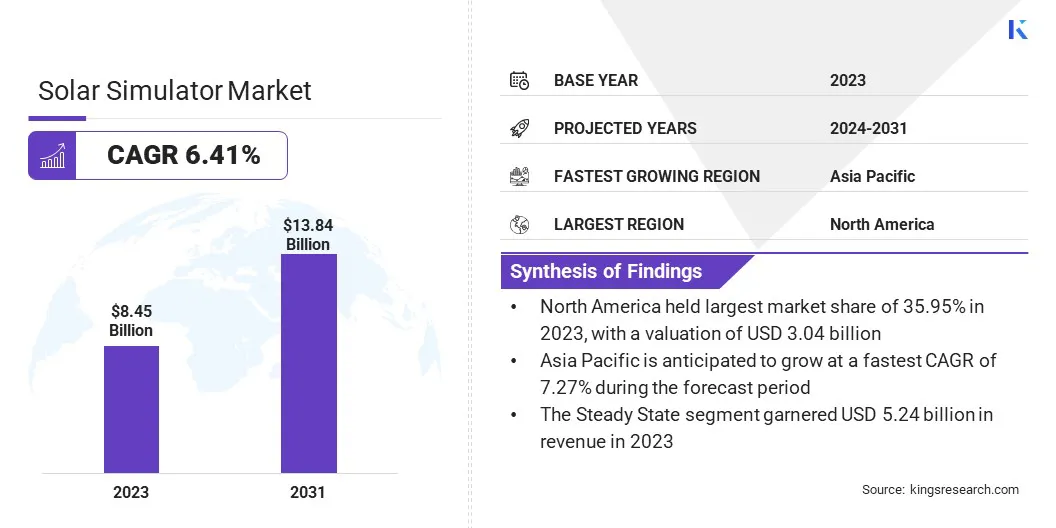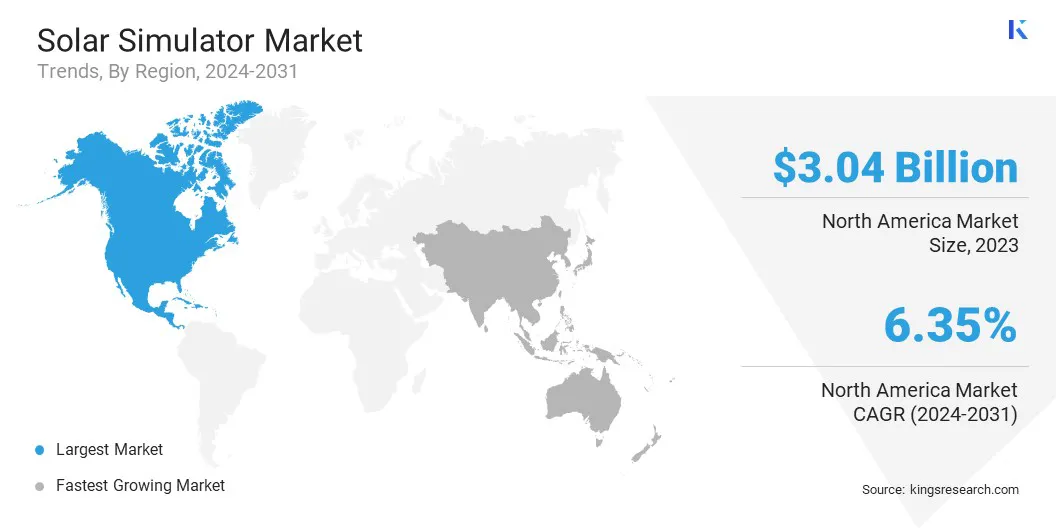Market Definition
The market includes equipment and systems designed to replicate natural sunlight for various testing and research purposes. These simulators are widely used in industries such as photovoltaics, automotive, aerospace, and materials science to assess the performance, durability, and efficiency of solar-powered products and components.
The report highlights key market drivers, major trends, regulatory frameworks, and the competitive landscape shaping the industry’s growth.
Solar Simulator Market Overview
The global solar simulator market size was valued at USD 8.45 billion in 2023 and is projected to grow from USD 8.95 billion in 2024 to USD 13.84 billion by 2031, exhibiting a CAGR of 6.41% during the forecast period.
Advancements in photovoltaic technologies are driving the need for more precise testing, prompting a shift towards LED-based solar simulators. These systems offer improved spectral accuracy, energy efficiency, and flexibility, making them ideal for next-generation multi-junction solar cell evaluation.
Major companies operating in the solar simulator industry are Abet Technologies, Inc., Meyer Burger Technology AG, Newport Corporation, G2V Optics Inc., Sciencetech Inc, AMETEK, Inc., LiveStrong Optoelectronics Co., Ltd., Climats, Spire Solar Iberia, IWASAKI ELECTRIC CO., LTD., TS-Space Systems LTD, Gsola.cn, OAI, Endeas, and Enlitech.
The increasing adoption of high-flux solar simulation technology is emerging as a key driving factor in the solar simulation market. These simulators enable high-intensity, controlled testing environments that are critical for the development and validation of concentrated solar power (CSP) systems, high-temperature solar receivers, and thermal energy storage solutions.
With growing investments in solar thermal technologies and hybrid renewable systems, the demand for precise, high-temperature testing tools is accelerating.
- In February 2025, the American Society of Mechanical Engineers published a study on a dual-actuator control strategy using a high-flux solar simulator to regulate temperature in high-temperature solar receivers, supporting the development of advanced concentrated solar power systems.

Key Highlights:
- The solar simulator market size was recorded at USD 8.45 billion in 2023.
- The market is projected to grow at a CAGR of 6.41% from 2024 to 2031.
- North America held a market share of 35.95% in 2023, with a valuation of USD 3.04 billion.
- The steady state segment garnered USD 5.24 billion in revenue in 2023.
- The metal halide arc lamp segment is expected to reach USD 3.80 billion by 2031.
- The UV testing of materials and products segment is anticipated to witness the fastest CAGR of 6.94% during the forecast period.
- Asia Pacific is anticipated to grow at a CAGR of 7.27% during the forecast period.
Market Driver
Increased Demand for Advanced Technology
The market is experiencing increased demand for advanced technologies as industries aim to improve solar power system efficiency.
These technologies offer accurate models of solar energy generation under various environmental conditions, supporting the design of more effective solar solutions. The growing adoption of renewable energy and the complexity of solar installations are further driving the need for enhanced simulation tools.
- In December 2024, NASA Glenn Research Center enhanced its solar simulation capabilities with advanced solar simulators, including the X-25 and programmable LED systems, to support the testing and calibration of photovoltaic devices for space missions.
Market Challenge
Ensuring Accurate Simulation of Real-World Environmental Conditions
A challenge in the solar simulator market is the difficulty in replicating accurate real-world environmental conditions, such as variable UV radiation, temperature fluctuations, and humidity, within laboratory settings. Many existing solar simulators fail to account for the long-term degradation of solar panels under these complex conditions, leading to inaccurate performance predictions.
To address this, market players are developing advanced solar simulators equipped with adjustable spectral output, integrated thermal and humidity controls, and real-time monitoring systems. These features help replicate real-world conditions more accurately, allowing for precise assessment of photovoltaic module performance and durability.
Market Trend
Shift Towards LED-Based Solar Simulators
The market is witnessing a growing shift from traditional light sources to LED-based solar simulators, driven by the need for greater precision and flexibility in testing photovoltaic (PV) modules. LED-based systems allow for tunable spectra and targeted wavelength control, which is beneficial for evaluating advanced PV technologies like tandem and perovskite-silicon modules.
This trend is further driven by the rising demand for energy-efficient, durable, and compact simulation tools designed to more accurately replicate real-world solar conditions. This is driving broader adoption among research institutions and PV manufacturers due to their precision, stability, and longer operational life.
- In December 2024, researchers from Fraunhofer ISE (Institute for Solar Energy Systems), Germany introduced a procedure for measuring External Quantum Efficiency (EQE) of tandem photovoltaic modules using an LED-based solar simulator, ensuring precise calibration for advanced solar technologies like perovskite on silicon.
Solar Simulator Market Report Snapshot
|
Segmentation
|
Details
|
|
By Type
|
Steady State, Pulsed
|
|
By Light Source
|
Xenon Arc Lamp, Metal Halide Arc Lamp, UV Lamp, QTH Lamp, LED Lamp
|
|
By Application
|
PV Cell Module and Material Testing, UV Testing of Materials and Products, Automotive Testing, Biomass Study, Others
|
|
By Region
|
North America: U.S., Canada, Mexico
|
|
Europe: France, UK, Spain, Germany, Italy, Russia, Rest of Europe
|
|
Asia-Pacific: China, Japan, India, Australia, ASEAN, South Korea, Rest of Asia-Pacific
|
|
Middle East & Africa: Turkey, U.A.E., Saudi Arabia, South Africa, Rest of Middle East & Africa
|
|
South America: Brazil, Argentina, Rest of South America
|
Market Segmentation:
- By Type (Steady State, Pulsed): The steady state segment earned USD 5.24 billion in 2023 due to its widespread adoption in precise and continuous solar cell testing applications.
- By Light Source (Xenon Arc Lamp, Metal Halide Arc Lamp, UV Lamp, and QTH Lamp): The metal halide arc lamp segment held 27.44% of the market in 2023, due to its efficiency and reliability in providing stable light output for solar simulation applications.
- By Application (PV Cell Module and Material Testing, UV Testing of Materials and Products, Automotive Testing, and Biomass Study): The PV cell module and material testing segment is projected to reach USD 3.62 billion by 2031, owing to the increasing demand for high-efficiency photovoltaic cells and the need for advanced testing solutions in the renewable energy sector.
Solar Simulator Market Regional Analysis
Based on region, the global market has been classified into North America, Europe, Asia Pacific, Middle East & Africa, and Latin America.

North America solar simulator market share stood around 35.95% in 2023 in the global market, with a valuation of USD 3.04 billion. The market is experiencing significant growth due to the robust expansion of the solar industry in the region.
Strong government support, including tax incentives and renewable energy policies, is driving the widespread adoption of solar technologies across residential, commercial, and industrial sectors across North America. Additionally, continued advancements in solar testing technologies and boosting demand for high-precision simulators.
The development of efficient and accurate testing systems is driving market growth across the region by meeting the increasing need for reliable assessment of photovoltaic systems.
- In 2024, Canada’s CanmetENERGY in Varennes enhanced its solar simulation capabilities with advanced rooftop PV systems and indoor testing facilities, including a large-area solar simulator and grid simulator. These upgrades support high-efficiency solar technology development, performance standards, and grid integration to meet growing demand for reliable solar solutions.
Asia Pacific solar simulator industry is poised for significant growth at a robust CAGR of 7.27% over the forecast period. The market in the region is witnessing significant growth, driven by the increase in solar panel manufacturing, particularly in China and India.
Additionally, the growing demand for solar energy, driven by awareness of renewables, energy security needs, and emission goals is further contributing to market expansion.
Regulatory Frameworks
- The U.S. Department of Energy framework advances solar energy technologies through research, standards, and policies, impacting the market by promoting innovation and enhancing system efficiency with advanced simulation tools.
- The Europe Renewable Energy Directive (RED) framework aims to promote the use of renewable energy sources across member states. It impacts the market by setting binding targets for renewable energy adoption, driving investments in clean technologies, and encouraging innovation in sustainable energy solutions.
Competitive Landscape
Companies in the solar simulator market are expanding their business through strategic collaborations, acquisitions, and investments. They are focusing on developing advanced, modular solutions with enhanced capabilities for high-power solar and battery testing, catering to growing sectors like energy and automotive. These efforts aim to strengthen their market position and meet the increasing demand for precise testing technologies.
- In June 2024, AMETEK Programmable Power launched the Sorensen Mi-BEAM Series, offering a modular solution with solar array simulator software for high-power solar and battery testing, targeting advanced energy and automotive sectors.
List of Key Companies in Solar Simulator Market:
- Abet Technologies, Inc.
- Meyer Burger Technology AG
- Newport Corporation
- G2V Optics Inc.
- Sciencetech
- AMETEK Programmable Power Inc.
- LiveStrong Optoelectronics Co., Ltd.
- Climats
- Spire Solar Iberia
- IWASAKI ELECTRIC CO., LTD.
- TS-Space Systems LTD
- Gsola.cn.
- OAI
- Endeas
- Enlitech
Recent Developments (Product Launches)
- In June 2024, Sciencetech developed a custom high-flux solar simulator for a French government project to meet the rising demand for advanced solar testing. This system supports high-temperature applications and strengthens Sciencetech’s position in solar simulation technology.
- In June 2024, MBJ launched two new solar simulation products, the Light Soaking Unit and Steady State Sun Simulator. These tools support the development of emerging cell technologies like perovskites by enabling flexible and scalable testing of next-generation solar cells.
experincing


